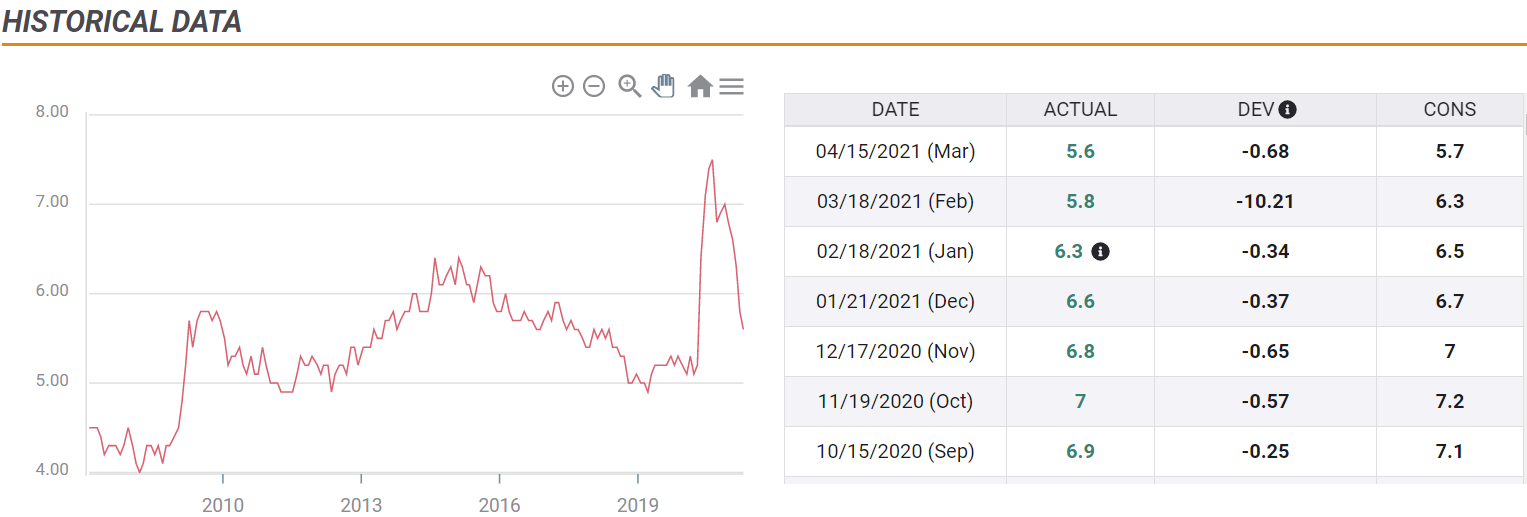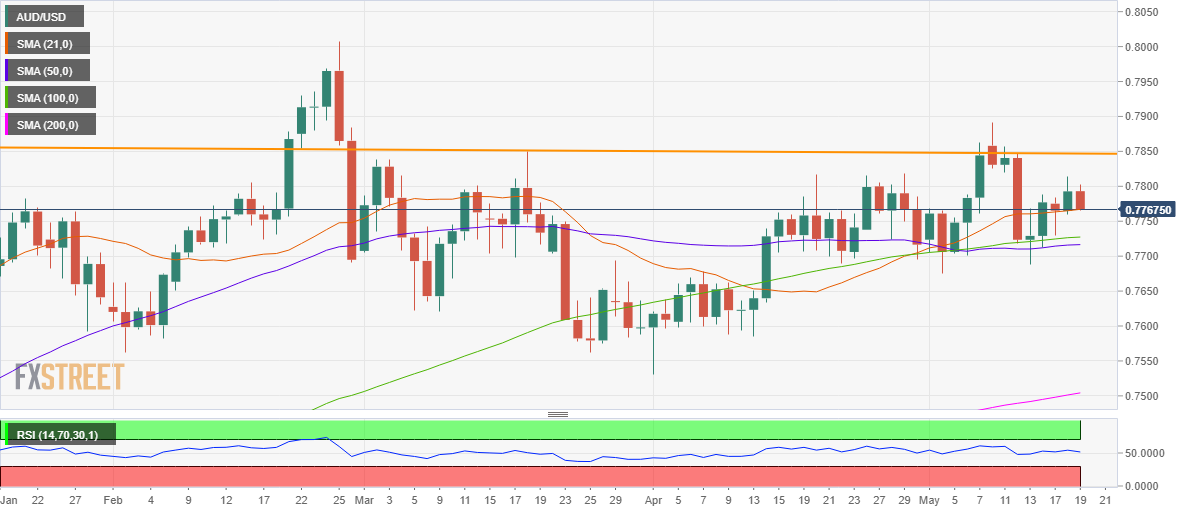- Australia’s unemployment rate to hold steady at 5.6% in April.
- The jobs report to reflect the impact of the end of the JobKeeper wage subsidy.
- RBA unlikely to act despite the wage growth. Employment, inflation goals still distant.
- Upside surprise to the employment data could lift AUD/USD towards 0.7850.
The Australian labor market recovery is likely to come to a standstill in April, reflecting the effect of the end of the government’s pandemic support program for businesses. The South Pacific Island nation’s relative success in combating the covid crisis and Reserve Bank of Australia’s (RBA) accommodative monetary policy, however, has led to a considerable improvement in the employment sector.
The Australian Bureau of Statistics (ABS) will release the April employment report at 0130GMT on Thursday. The Federal Government’s fiscal support and the vaccination success could revive Australia’s labor market recovery.
Unemployment rate steadies amid slower pace of hiring
The OZ economy is likely to see 15K jobs addition in April after creating 70.7K employment opportunities in March. The participation rate is expected to hold steady at 66.3%. The Unemployment Rate is expected to remains unchanged at 5.6% after dropping 0.2% in the previous while sitting at the lowest levels since March 2020.

Wage growth, jobs surprise unlikely to move the RBA
Despite the impressive post-pandemic economic rebound, as reflected by the recent series of upbeat macro indicators, the RBA is unlikely to alter its monetary policy settings.
However, the RBA April meeting’s minutes revealed that the board members “will decide in July whether to roll over to Nov 2024 bond, extend bond buying.”
This could be likely in light of assessing the progress in the labor market, as the end of the JobKeeper wage subsidy scheme takes its toll on the sector. Industry experts believed that the JobKeeper program helped Australia's unemployment rate to drop sharply from the peak of the pandemic in July 2020, when it spiked to 7.5%.
Meanwhile, the RBA has been very clear that it is unlikely to hike rates until its dual mandate of higher employment and inflation are met. Therefore, the wage growth seen in the Q1 of this year and a solid in rise in employment in mid-April is likely to be seen as a one-off, considering the seasonality factor around Easter.
However, markets continue to anticipate the labor market recovery to strength further out, courtesy of the Federal Government's 2021 Budget. Much of the budget is aimed at creating jobs in order to bring Australia's unemployment rate below 5%.
Treasurer Josh Frydenberg said recently, “the third Budget would create 250,000 jobs by the end of 2022-23,” adding that "Jobs are coming back."
AUD/USD probable scenarios
AUD/USD has stalled its recovery from last week’s low of 0.7687 ahead of Thursday’s employment report.
An upside surprise in the jobs data is needed to recall the aussie buyers, which could drive AUD/USD back above 0.7800. Further up, the critical horizontal trendline resistance near 0.7850 could be challenged. On disappointing figures, the aussie is likely to put solid support around 0.7715 at risk. That level is the confluence of the 50 and 100-day simple moving averages. The 14-day Relative Strength Index (RSI) still defends the midline, keeping the bullish potential intact.
However, the aussie’s reaction to the employment report could be also influenced by the persisting market mood, especially in light of the release of the FOMC April meeting’s minutes on Wednesday.
Daily chart

Information on these pages contains forward-looking statements that involve risks and uncertainties. Markets and instruments profiled on this page are for informational purposes only and should not in any way come across as a recommendation to buy or sell in these assets. You should do your own thorough research before making any investment decisions. FXStreet does not in any way guarantee that this information is free from mistakes, errors, or material misstatements. It also does not guarantee that this information is of a timely nature. Investing in Open Markets involves a great deal of risk, including the loss of all or a portion of your investment, as well as emotional distress. All risks, losses and costs associated with investing, including total loss of principal, are your responsibility. The views and opinions expressed in this article are those of the authors and do not necessarily reflect the official policy or position of FXStreet nor its advertisers. The author will not be held responsible for information that is found at the end of links posted on this page.
If not otherwise explicitly mentioned in the body of the article, at the time of writing, the author has no position in any stock mentioned in this article and no business relationship with any company mentioned. The author has not received compensation for writing this article, other than from FXStreet.
FXStreet and the author do not provide personalized recommendations. The author makes no representations as to the accuracy, completeness, or suitability of this information. FXStreet and the author will not be liable for any errors, omissions or any losses, injuries or damages arising from this information and its display or use. Errors and omissions excepted.
The author and FXStreet are not registered investment advisors and nothing in this article is intended to be investment advice.
Recommended Content
Editors’ Picks

EUR/USD treads water just above 1.0400 post-US data
Another sign of the good health of the US economy came in response to firm flash US Manufacturing and Services PMIs, which in turn reinforced further the already strong performance of the US Dollar, relegating EUR/USD to the 1.0400 neighbourhood on Friday.

GBP/USD remains depressed near 1.2520 on stronger Dollar
Poor results from the UK docket kept the British pound on the back foot on Thursday, hovering around the low-1.2500s in a context of generalized weakness in the risk-linked galaxy vs. another outstanding day in the Greenback.

Gold keeps the bid bias unchanged near $2,700
Persistent safe haven demand continues to prop up the march north in Gold prices so far on Friday, hitting new two-week tops past the key $2,700 mark per troy ounce despite extra strength in the Greenback and mixed US yields.

Geopolitics back on the radar
Rising tensions between Russia and Ukraine caused renewed unease in the markets this week. Putin signed an amendment to Russian nuclear doctrine, which allows Russia to use nuclear weapons for retaliating against strikes carried out with conventional weapons.

Eurozone PMI sounds the alarm about growth once more
The composite PMI dropped from 50 to 48.1, once more stressing growth concerns for the eurozone. Hard data has actually come in better than expected recently – so ahead of the December meeting, the ECB has to figure out whether this is the PMI crying wolf or whether it should take this signal seriously. We think it’s the latter.

Best Forex Brokers with Low Spreads
VERIFIED Low spreads are crucial for reducing trading costs. Explore top Forex brokers offering competitive spreads and high leverage. Compare options for EUR/USD, GBP/USD, USD/JPY, and Gold.